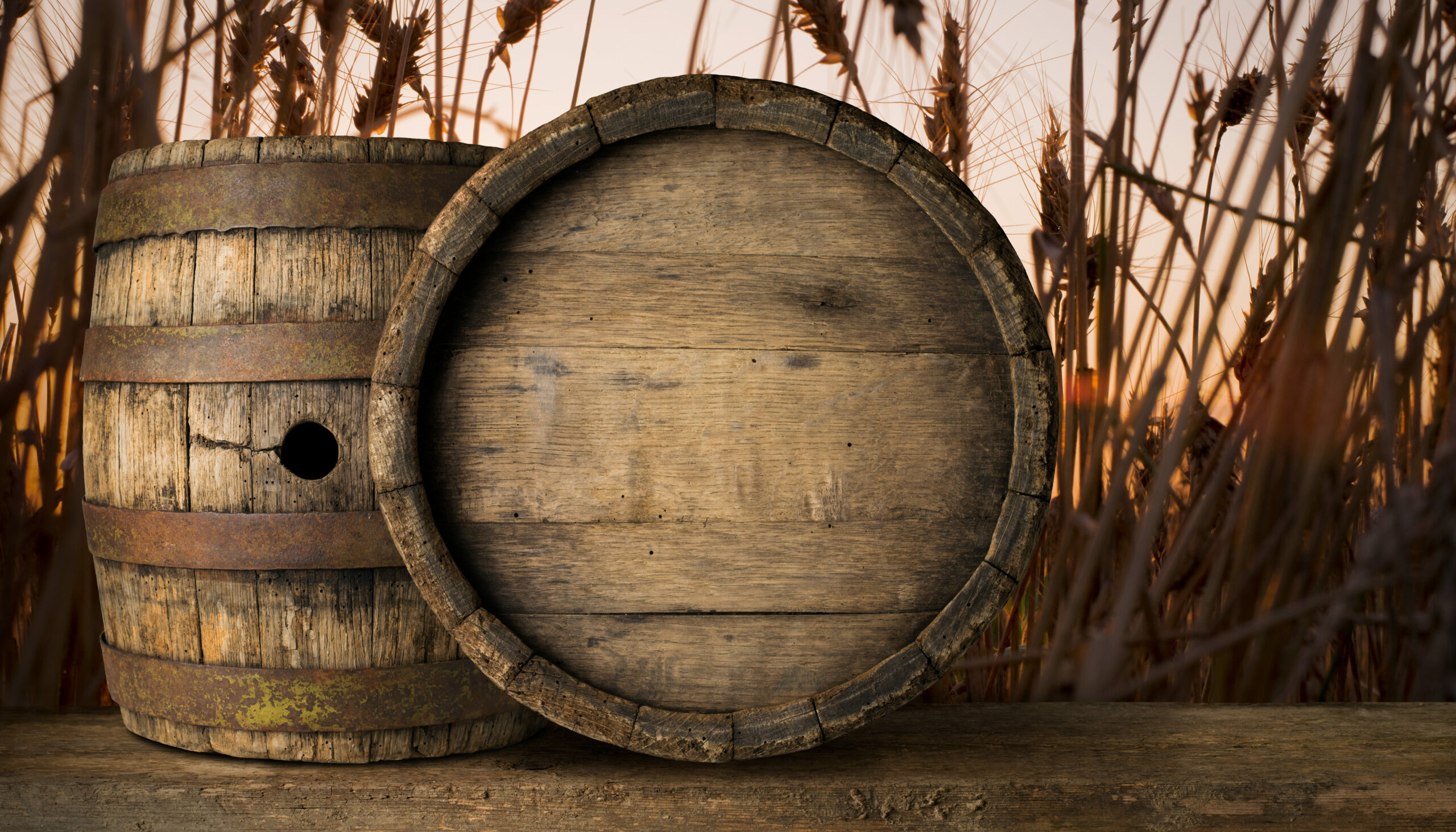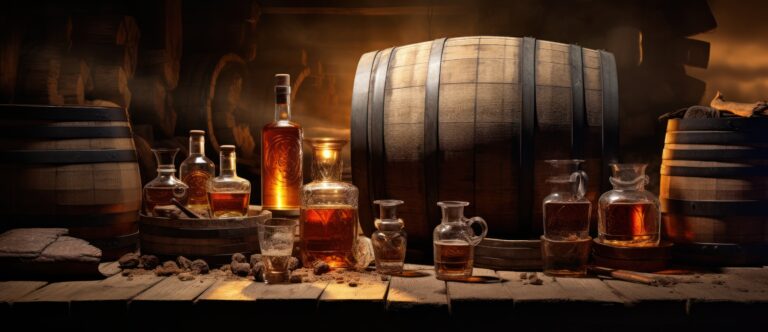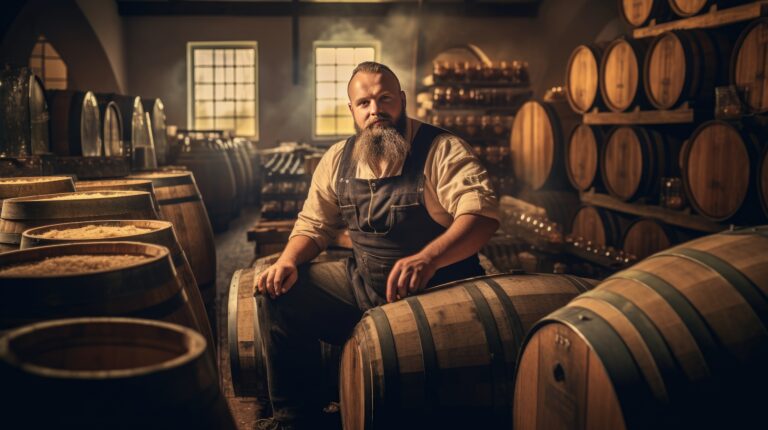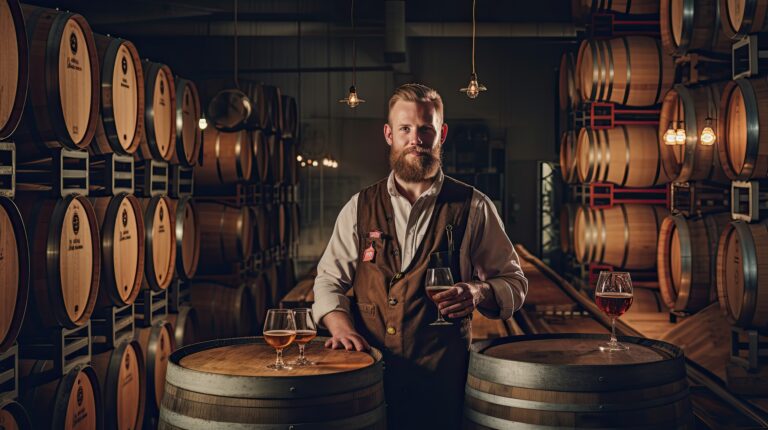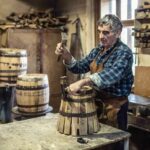Ever wonder how distillers conjure those intricate and downright delicious whiskeys you savor? The real magic lies within the barrel aging process. As a true whiskey connoisseur, you already know that time spent nestled in oak imparts distinctive flavor, rich color, and captivating aroma to the distilled spirit. But get this: some distillers employ a fascinating technique called sequential barrel aging to craft truly one-of-a-kind and unforgettable whiskeys.
An Introduction to Barrel Aging for Whiskey
Barrel aging isn’t just a step; it’s the very foundation of creating complex and flavorful whiskeys. The art of sequential barrel aging elevates this crucial process to an entirely new level of sophistication.
How Sequential Barrel Aging Works
Imagine a whiskey taking a flavorful journey through a series of barrels, each crafted from different woods. That’s essentially sequential barrel aging. Typically, the spirit begins its maturation in freshly charred new oak barrels, where it eagerly soaks up those classic vanilla and sweet caramel notes. Then comes the transfer to used barrels, often seasoned bourbon casks, for a deeper, more nuanced development.
These used barrels gently introduce more subtle complexities, think hints of dried fruit, warm nuts, and aromatic spices. Some adventurous distillers even incorporate sherry casks, port casks, or even rum casks to bestow an extra layer of intriguing flavor. The crucial element? Allowing ample time within each barrel for the whiskey to truly embrace the unique characteristics of the wood.
Benefits of Sequential Barrel Aging
This multi-barrel approach unlocks an intricate tapestry of flavors that single barrel aging simply can’t achieve. With each transition, the whiskey becomes remarkably smoother and more mellow. Its color also deepens gradually, transforming into a rich, inviting amber hue.
Sequential barrel aging is the secret ingredient behind the captivating complexity and aroma of premium whiskeys. True aficionados will often detect initial whispers of vanilla and perhaps a touch of sherry, gracefully followed by deeper notes of comforting maple syrup, rich cocoa, robust coffee, or delicate toasted almonds. The subtle interplay of these flavors evolves with each batch, promising a truly unique tasting experience.
For the discerning whiskey connoisseur, the hallmark of a truly exceptional dram is its lingering aftertaste. Sequential barrel aging plays a vital role in crafting whiskeys with a long, memorable finish – the undeniable signature of a fine, artisanal spirit. The skill and unwavering patience demanded by this technique are precisely what make these rare, vintage whiskeys so highly prized. But for those who deeply value quality and exceptional taste, the extra time and care invested in production are undeniably worth the wait.
What Is Sequential Barrel Aging?
In essence, sequential barrel aging is a specialized technique employed by distillers to coax uniquely complex flavors from whiskeys and other fine spirits.
How It Works
Distillers embark by selecting a base spirit, such as bourbon or rye, and initiating its aging journey in charred oak barrels. Once the spirit reaches a certain level of maturity, it’s carefully transferred to a second barrel, often one that previously cradled a different type of liquor, like port, sherry, or even wine.
During its time in the first barrel, the spirit diligently absorbs foundational flavors and enticing aromas, such as comforting vanilla, sweet caramel, and classic oak notes. When it moves to the second barrel, it mingles with the lingering essence of the previous spirit, gracefully picking up fruity, nutty, or spicy nuances. The remarkable result is a whiskey boasting layered, multidimensional flavor.
Some particularly meticulous distillers repeat this fascinating process, utilizing three or even more barrels to achieve spirits with an even more intricate and captivating blend of tastes. The longer a spirit resides in each barrel and the greater the variety of barrels employed, the more profound and complex its flavor profile becomes.
Why Age in Different Barrels?
Barrel aging is undeniably the key to bestowing upon whiskey its distinctive taste and inviting color. However, barrels can only impart a finite amount of flavor over time. Once a spirit has matured within a barrel for many years, it reaches a plateau and can even begin to lose some of its vibrancy.
Sequential aging offers distillers a clever way to repurpose barrels and continue enhancing the spirit’s flavor long after the initial barrel has given its all. It’s an ingenious method for crafting whiskeys with rich, nuanced tastes that truly stand out from the crowd.
For the discerning whiskey connoisseur in pursuit of a truly unique drinking experience, sequentially aged spirits represent the very pinnacle of the craft. Each barrel in the sequence contributes another delicate layer of aroma and captivating taste, culminating in a complex yet beautifully harmonious blend of flavors.
The History Behind This Innovative Technique
The art of aging whiskey in multiple barrels, known as sequential barrel aging or barrel finishing, boasts a rich history spanning centuries, all in the pursuit of more complex and full-bodied flavors. Early distillers long ago discovered that transferring whiskey from one barrel to another, a process they called “barrel finishing,” allowed for the development of more nuanced and intriguing tastes.
The Early Days
The roots of barrel finishing can be traced back to the 1700s, the dawn of aging spirits in charred oak casks. As the whiskey interacted with the wood, remarkable new flavors began to emerge. Astute distillers observed further intriguing changes when they moved the whiskey to a second barrel. This insightful technique gained significant popularity in the mid-1800s, with numerous distilleries eagerly experimenting with diverse barrel types – often those that previously held port, sherry, rum, or wine.
Modern Innovation
Today, visionary master distillers are pushing the boundaries of barrel finishing to unprecedented heights, utilizing barrels that once held unexpected treasures like maple syrup, fragrant coffee beans, or robust stout beer. Some even collaborate with local wineries or craft brewers, employing their used barrels to create truly regionally inspired flavors. The potential combinations are virtually limitless!
Sequential barrel aging empowers the whiskey to meticulously extract different flavors from each carefully chosen barrel. The initial barrel, typically crafted from charred American white oak, generously imparts those familiar vanilla and sweet caramel notes. Subsequent barrels then contribute additional layers of complexity, such as the richness of dried fruit, the warmth of chocolate, the boldness of coffee, or the earthiness of toasted almonds, all depending on the unique character of the barrel type. The remarkable result is an ultra-premium whiskey boasting unparalleled taste and distinctive character.
Some pioneering distilleries are even experimenting with “double barrel” or “triple barrel” finishes, employing up to three distinct barrels to achieve the absolute maximum flavor impact. The extra care and meticulous attention demanded by these multiple barrel finishes are undeniably evident in the exquisite final product. For the discerning whiskey connoisseur seeking a spirit with profound depth and captivating complexity, sequentially barrel-aged whiskies represent the very pinnacle of the distiller’s art.
The history of barrel finishing serves as a powerful reminder that true innovation often involves revisiting traditional techniques with a fresh and creative perspective. By honoring the wisdom of the past while fearlessly pioneering new flavor profiles, today’s distillers are crafting whiskies of exceptional quality and distinction. For the passionate whiskey lover, there has never been a more exciting time to explore the vast and diverse range of tastes achieved through the masterful art of sequential barrel aging.
How Sequential Barrel Aging Works
Sequential barrel aging is a meticulous technique employed by master distillers to craft uniquely complex whiskeys. They carefully mature the whiskey in a carefully selected series of barrels made from different woods to impart a symphony of distinctive flavors and captivating aromas.
The Process
The whiskey embarks on its aging journey in charred oak barrels, most commonly crafted from American white oak. After a significant period, typically ranging from 3 to 5 years, a portion of the maturing spirit is thoughtfully transferred to a second barrel fashioned from a different wood, such as cherry, maple, or hickory. As the whiskey interacts with this new wood, it diligently absorbs different flavor compounds and undergoes further mellowing. Some particularly dedicated distillers even utilize up to 4 or 5 different barrels in a precise sequence.
With each careful barrel transfer, the whiskey subtly picks up the unique essence of the wood. For instance, aging in ex-maple syrup barrels can impart delicate hints of maple sugar, while ex-sherry casks contribute rich, nutty, and dried fruit notes. The resulting spirit is a complex, multi-dimensional creation unlike any other.
Blending the Results
Once the whiskey has reached its desired level of maturity in each of the sequential barrels, portions from each are skillfully blended together to create the final product. The master distiller meticulously balances the various flavors to highlight the most desirable qualities imparted by each wood. Due to the natural variations inherent in the wood and the whiskey’s unique interaction with it, no two batches are ever exactly alike.
Several well-respected brands, including Maker’s Mark, Jim Beam, and Jack Daniel’s, utilize elements of sequential barrel aging in some of their premium, limited-release whiskies, resulting in distinct flavor profiles highly sought after by discerning whiskey connoisseurs.
The significant time, exceptional skill, and boundless creativity that go into sequential barrel aging are what ultimately produce spirits of exceptional depth, character, and unparalleled quality. For the passionate whiskey lover eager to explore the outer reaches of flavor, these are the remarkable drams that truly deserve a place in your glass.
The Complex Flavors Created Through Multiple Barrels
The ingenious technique of aging whiskey in multiple barrels, aptly named sequential barrel aging, empowers distillers to orchestrate an intricate symphony of flavors in the final spirit.
As the whiskey gracefully moves from one barrel to the next, it diligently absorbs the unique characteristics inherent in each type of wood. The initial barrel, typically fashioned from American white oak, generously provides those bold vanilla and comforting caramel notes that we so readily associate with classic bourbon and smooth Tennessee whiskeys.
A Second Act
Upon its transfer to a second barrel, the whiskey begins to mingle with the distinct flavors offered by different wood varieties. A barrel crafted from French oak might impart delicate hints of warm spice and rich dried fruit. A barrel that once cradled luscious port or elegant sherry introduces intriguing notes of ripe berry and earthy nut. Even barrels that previously held fine wines or flavorful beers can leave subtle yet discernible traces of their former occupants, leading to wonderfully unexpected flavor combinations.
An Oak Barrel Finale
For the final stage of its maturation journey, the whiskey is often thoughtfully returned to charred American oak barrels. Here, the diverse medley of flavors carefully developed in the preceding barrels gracefully fuse into a harmonious and well-rounded whole. The familiar and comforting oak notes return, now beautifully accompanied by an array of new and intriguing tastes acquired during the whiskey’s flavorful voyage.
This additional time spent in oak barrels also allows the whiskey to further mellow and smooth out any remaining rough edges. Tannins gently break down, any lingering bitterness fades away, and a luxurious, silky mouthfeel emerges. The exquisite end result is a whiskey boasting captivating layers of complex, intermingling flavors and a finish that gracefully lingers on the palate.
Sequential barrel aging is truly an art form, and the specific combination of barrels employed is a closely guarded secret, unique to each individual distiller. By meticulously controlling this fascinating alchemy of wood and time, master distillers are creating whiskies with profound depth, captivating nuance, and distinctive character that truly stand out from the ordinary. For the discerning whiskey connoisseur seeking a truly multi-dimensional drinking experience, sequentially aged spirits deliver in spades.
Examples of Whiskeys Using Sequential Aging
Many innovative whiskey makers utilize a diverse array of barrels during the aging process to imbue their spirits with complex and intriguing flavors. One such technique, sequential barrel aging, involves aging the whiskey in different barrels over a carefully determined period. Here are a few notable examples of whiskies that skillfully employ this multi-barrel approach:
- Elijah Craig Barrel Proof Bourbon undergoes a fascinating journey during its 12 years of aging, being transferred between charred oak barrels and used barrels. The charred barrels contribute classic vanilla and sweet caramel notes, while the used barrels impart more pronounced oak and warm spice flavors.
- High West Yippee Ki-Yay Whiskey, a unique blend of straight rye whiskeys, receives a final touch by being finished in barrels that previously held both French oak and rich Syrah wine. This varied barrel selection allows the rye to develop intriguing notes of comforting maple, aromatic clove, and luscious dark fruit.
- Westland Garryana Edition Whiskey showcases the influence of native Garry oak by aging its malt whiskey in three distinct barrel types: new American oak, refill hogshead, and the unique Garry oak. The native oak, in particular, contributes distinctive tropical fruit and subtle coconut flavors.
- Compass Box The Story of the Spaniard Whisky masterfully combines single malts aged in Spanish oak ex-sherry casks, American oak ex-bourbon casks, and French oak ex-wine casks. The resulting whisky is a complex tapestry of dried fruits, warm nuts, and comforting baking spices.
By strategically utilizing a variety of barrels and carefully timing the transfers between them during the aging process, distillers can unlock a wider spectrum of more complex and truly unusual flavors within the spirit. Master distillers can artfully create unique taste profiles by meticulously customizing their barrel selections and the precise timing of transfers between these casks. For the adventurous whiskey lover seeking bold and distinctive flavors, a sequentially aged whiskey can be a truly exceptional and rewarding treat.
The Advantages of Sequential Barrel Aging
The ingenious technique of sequential barrel aging empowers distillers to craft uniquely complex and exceptionally flavorful whiskies. Rather than simply aging the spirit in a single barrel for an extended duration, distillers thoughtfully move the whiskey into different barrels over time. This strategic process exposes the whiskey to a diverse range of wood types and varying levels of char, allowing for the extraction of a wider array of distinct flavors from each barrel.
Different wood types, such as classic oak, smoky hickory, or sweet maple, impart their own unique aroma and flavor compounds to the developing whiskey. By carefully transitioning between barrels crafted from these different woods, distillers can create captivating layers of flavors that would be simply unattainable from a single wood type.
The level of char or toast applied to the inside of the barrel also significantly influences the whiskey’s final taste. A lightly charred barrel might contribute delicate notes of creamy vanilla, while a heavily charred barrel can impart bolder flavors reminiscent of warm clove or rich espresso. By thoughtfully transferring the whiskey to barrels with varying char levels, distillers can cultivate a nuanced spectrum of roasted flavors.
The age of each barrel also plays a crucial role in the flavor development. An older, more seasoned barrel has already released a significant portion of its tannins and lignins to previous occupants. This means the whiskey will extract fewer potentially bitter compounds, resulting in a smoother and more mellow taste. Conversely, newer barrels impart a more robust and distinctly wood-forward character.
Furthermore, environmental factors such as temperature fluctuations, humidity levels, and barometric pressure can vary significantly between different barrel aging locations. These subtle differences influence how the whiskey interacts with the wood, creating unique variations between individual barrels. By strategically aging the whiskey sequentially in barrels stored in separate locations, distillers can introduce even more intricate layers of complexity.
By thoughtfully moving the whiskey between barrels of different types, ages, char levels, and environmental conditions over time, master distillers can artfully craft an intricate web of flavors that would be simply impossible to achieve through traditional single-barrel aging. The remarkable result is an exceptionally complex, multi-dimensional whiskey that truly captivates the palate. For the discerning whiskey connoisseur seeking new and exciting taste experiences, sequentially barrel-aged spirits represent the very cutting edge of an age-old and revered craft.
How Long Does the Aging Process Take?
The aging process for complex whiskies crafted using the sequential barrel aging technique typically spans at least 2 to 3 years, but often extends much longer to fully develop the desired intricate flavor profile.
The First Barrel
The whiskey initially begins its maturation journey in charred oak barrels that previously held either bourbon or rum. This initial aging period, often referred to as the “first fill,” typically lasts a minimum of 2 years. During this crucial time, the whiskey diligently absorbs foundational flavors and enticing aromas from the barrels, such as comforting vanilla, sweet caramel, and warm spice notes. The longer the whiskey ages in this first barrel, the more pronounced these initial flavors become.
The Second Barrel
Once the master distiller determines that the whiskey has sufficiently matured in the first barrel, it is carefully transferred, or “dumped,” into a second set of used barrels. These subsequent barrels previously housed different spirits, such as rich port, elegant sherry, or fine wine, and impart entirely new and intriguing layers of flavor to the developing whiskey. This second stage of barrel aging, often referred to as “finishing,” can last anywhere from 6 to 18 months, and in the case of some premium whiskies, even several years.
Blending and Bottling
Finally, the carefully matured contents of multiple barrels are skillfully blended together, and the whiskey is then bottled. The specific blend of ages, barrel types, and precise aging times varies significantly between different whiskey brands and expressions. Master distillers meticulously select and artfully combine barrels to achieve the desired complex flavor profile and harmonious balance in the final bottled product.
An Extended Journey
From the very beginning to the final bottling, a premium whiskey crafted using sequential barrel aging can undergo a maturation process lasting at least 4 to 5 years, and often extending well over a decade. This extended aging period and the thoughtful barrel finishing contribute significantly to creating an exceptionally smooth and complex spirit boasting a multitude of captivating aromas and intricate flavors. For the dedicated whiskey connoisseur, this long and intricate journey is undeniably worth the patient wait. The remarkable end result is a whiskey that offers a new and exciting experience with every thoughtful sip.
The lengthy aging process demanded by premium, barrel-finished whiskies naturally results in a more premium price point, but for many discerning drinkers, the unparalleled complexity and exceptional taste are well worth the additional investment. Savouring a glass of finely-aged, sequential barrel whiskey is akin to embarking on an epic flavor exploration – you never quite know what delightful new aromas and intriguing tastes you might discover.
The Future of Sequential Barrel Aging for Whiskeys
The future of meticulously barrel aging whiskies is undeniably bright and full of exciting possibilities. Distillers are embracing experimentation more than ever before, exploring diverse types of barrels, unique wood varieties, and innovative aging techniques to craft truly groundbreaking and complex flavors.
Hybrid Barrels
Some forward-thinking distillers are now aging their prized whiskies in innovative barrels constructed from staves sourced from different types of wood. By artfully blending oak varieties such as American, French, and Hungarian, they can achieve entirely unique and captivating flavor profiles. The potential combinations are truly endless and ripe for exploration.
Non-Traditional Wood Varieties
A growing number of adventurous craft distillers are venturing beyond traditional oak, aging their whiskies in barrels crafted from other intriguing woods like cherry, maple, and hickory. These non-traditional woods can impart distinct fruity, subtly smoky, or delicately nutty notes to the final spirit. However, utilizing non-oak barrels often requires careful adjustments to the aging process to prevent the wood flavors from overpowering the inherent character of the whiskey.
Heavily Toasted or Charred Barrels
The degree of toasting and charring applied to the inside of the barrels before filling them has a significant impact on the resulting whiskey. Heavily toasted or charred barrels can lead to bolder and spicier flavors in the aged spirit. Some distillers are experimenting with using heavily toasted or charred oak barrels for the entire aging period, while others are employing them as a final finishing step for just a few months to maximize the flavor impact.
Blending Barrel-Aged Whiskies
Master distillers are also pushing the boundaries of flavor creation by skillfully blending whiskies that have been aged in distinctly different types of barrels. For example, a robust bourbon aged in new charred oak barrels can be artfully blended with a more nuanced whiskey aged in used barrels to perfectly balance sweet and spicy oak notes. This strategic blending opens up a vast array of possibilities for crafting entirely new and complex flavor profiles.
The burgeoning interest in premium and craft whiskies is undoubtedly driving more innovation in both barrel aging and intricate finishing techniques. As distillers continue to fearlessly push the boundaries of flavor, sequential barrel aging and masterful barrel blending will empower them to create whiskies with unprecedented depth, unique character, and captivating complexity. The future of meticulously barrel-aged whiskies looks incredibly promising indeed.
Final Thoughts
Overall, the intricate process of sequential barrel aging stands as a true art form, demanding immense patience, unwavering precision, and an unwavering dedication to the highest levels of quality. As a discerning whiskey connoisseur, you inherently understand that the complex and rewarding flavors that grace your glass at the end of the day are the result of immense care and expert craftsmanship. Master distillers meticulously craft these premium spirits by beginning with only the finest quality ingredients and then relying on the fascinating alchemy of wood and the passage of time. Now that you’ve gained a deeper glimpse inside the barrels, you can undoubtedly appreciate the immense hard work and unwavering passion that goes into creating a truly smooth and memorably flavorful whiskey. The next time you thoughtfully swirl, deeply sniff, and slowly sip one of your favorite aged spirits, take a moment to raise your glass in appreciation for the true masters of the craft who have invested years of their lives so that you can fully enjoy the remarkable fruits of their dedicated labor. Sequential barrel aging may still hold a touch of mystique, but its exquisite results are undeniably meant to be savored and deeply appreciated.
